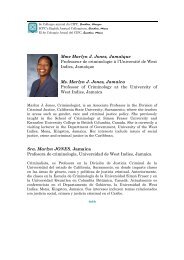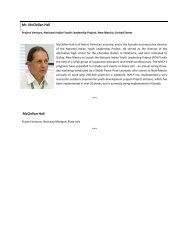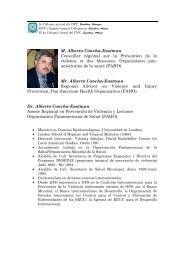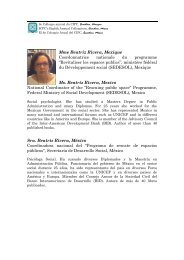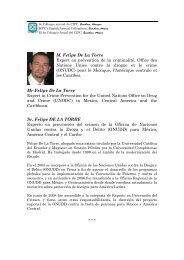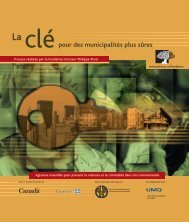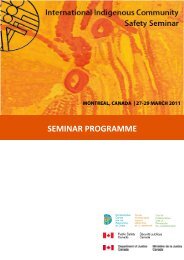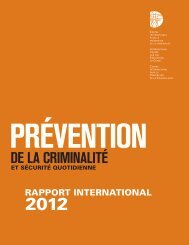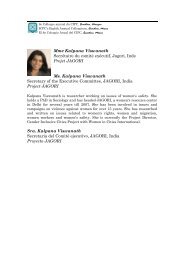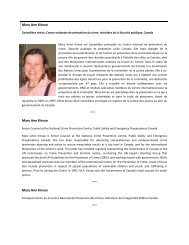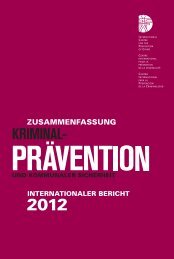Dr. Alexander Butchart - International Centre for the Prevention of ...
Dr. Alexander Butchart - International Centre for the Prevention of ...
Dr. Alexander Butchart - International Centre for the Prevention of ...
You also want an ePaper? Increase the reach of your titles
YUMPU automatically turns print PDFs into web optimized ePapers that Google loves.
<strong>Alexander</strong> <strong>Butchart</strong><br />
Department <strong>of</strong> Violence and Injury <strong>Prevention</strong> and Disability, Organisation mondiale de la Santé (OMS)<br />
<strong>Dr</strong>. <strong>Alexander</strong> <strong>Butchart</strong> coordinates <strong>the</strong> Violence <strong>Prevention</strong> Team (PVL), Department <strong>of</strong> Violence and Injury<br />
<strong>Prevention</strong> and Disability, World Health Organization (WHO). His main task is to implement <strong>the</strong> recommendations<br />
<strong>of</strong> <strong>the</strong> World Report on violence and health. This involves <strong>the</strong> development <strong>of</strong> technical guidelines, policy papers<br />
and research that can be used to support applied prevention programmes and advocate <strong>for</strong> increased investment<br />
in violence prevention. Specific projects include country‐level violence prevention demonstration programmes, <strong>the</strong><br />
systematic documentation <strong>of</strong> violence prevention programmes, and research into <strong>the</strong> economic dimensions <strong>of</strong><br />
interpersonal violence, including <strong>the</strong> costs <strong>of</strong> its consequences and <strong>the</strong> cost‐effectiveness <strong>of</strong> preventive<br />
programmes. He is a native <strong>of</strong> South Africa. Prior to commencing work with WHO in May 2001, he was an Associate<br />
Pr<strong>of</strong>essor at <strong>the</strong> University <strong>of</strong> South Africa’s Institute <strong>for</strong> Social and Health Sciences. He completed his doctorate in<br />
1995. He was a founder member <strong>of</strong> <strong>the</strong> Injury <strong>Prevention</strong> Initiative <strong>for</strong> Africa, and from 1998 to April 2001 was lead<br />
scientist <strong>for</strong> <strong>the</strong> South African Violence and Injury Surveillance Consortium.<br />
***<br />
<strong>Alexander</strong> <strong>Butchart</strong><br />
Department <strong>of</strong> Violence and Injury <strong>Prevention</strong> and Disability, Organización Mundial de la Salud
COMMENTARY:<br />
FROM CRIME PREVENTION TO<br />
SAFE COMMUNITIES<br />
<strong>Alexander</strong> <strong>Butchart</strong><br />
Coordinator, <strong>Prevention</strong> <strong>of</strong> Violence<br />
World Health Organization<br />
Switzerland
LET'S GET BACK TO THE FUTURE AND STAY THERE<br />
LONG ENOUGH TO MAKE PREVENTION A<br />
PERMANENT FEATURE OF THE POLICY AND<br />
PROGRAMME LANDSCAPE.
Has violence prevention really arrived<br />
• In Connecticut, <strong>the</strong> 2004 budget <strong>for</strong><br />
home visiting and related<br />
preventive services was $7.2<br />
million per year.<br />
• The budget <strong>for</strong> <strong>the</strong> state’s child<br />
protective service agency was<br />
$650 million.<br />
• The ratio <strong>of</strong> child protection to<br />
prevention was 90 to 1.<br />
• Imagine how much more<br />
prevention could be accomplished<br />
if in every community <strong>the</strong> ratio<br />
were closer to 10 to 1.<br />
Leventhal JM. Editorial. Getting prevention right: maintaining <strong>the</strong> status<br />
quo is not an option. Child Abuse & Neglect 29 (2005), 209–213
Are Safe Communities yet to come<br />
Indicators <strong>for</strong> Safe Communities<br />
•Infrastructure based on partnership and<br />
collaborations, governed by a crosssectional<br />
group responsible <strong>for</strong> safety<br />
promotion in <strong>the</strong>ir community;<br />
•Long-term, sustainable programs covering<br />
both genders and all ages, environments,<br />
and situations;<br />
•Programs that target high-risk groups and<br />
environments, and promote safety <strong>for</strong><br />
vulnerable groups;<br />
•Programs that document <strong>the</strong> frequency and<br />
causes <strong>of</strong> injuries;<br />
•Evaluation measures to assess programs,<br />
processes and <strong>the</strong> effects <strong>of</strong> change;<br />
•Ongoing participation in national and<br />
international Safe Communities networks.
The Safe Communities Network<br />
Designated Members<br />
Norway<br />
Alvdal<br />
Bergen<br />
Fredrikstad<br />
Harstad<br />
Høyanger<br />
Klepp<br />
Kvam<br />
Larvik<br />
Os<br />
Rakkestad<br />
Sogn &Fjordane<br />
Ski<br />
Spydeberg<br />
Stovner<br />
Trondheim<br />
Vågå<br />
Årdal<br />
Sweden<br />
Arjeplog<br />
Borås<br />
Falköping<br />
Falun<br />
Katrineholm<br />
Krokom<br />
Lidköping<br />
Ludvika<br />
Mariestad<br />
Motala<br />
Nacka<br />
Skövde<br />
Smedjebacken<br />
Staffanstorp<br />
Tidaholm<br />
Töreboda<br />
Uddevalla<br />
http://www.phs.ki.se/csp/<br />
Denmark<br />
Horsens<br />
Finland<br />
Hyvinkää<br />
Kouvola<br />
Estonia<br />
Rapla<br />
Ne<strong>the</strong>rlands<br />
Rotterdam<br />
Austria<br />
Vorarlberg<br />
Poland<br />
Tarnowskie Góry<br />
Serbia<br />
Backi Petrovac<br />
Novi Sad<br />
Czech Republic<br />
Chrudim<br />
Kromeriz<br />
Trebon<br />
Bosnia (B&H)<br />
Konjic<br />
Iran<br />
Arsenjan<br />
Bardaskan<br />
District 22<br />
Kashmar<br />
Israel<br />
Raanana<br />
South Africa<br />
Eldorado Park<br />
Broadlands Park &<br />
Nomzamo<br />
China<br />
Anzhen<br />
Balizhuang<br />
Dongzhimen<br />
Financial Sub-district<br />
Honey Lake<br />
Hongqiao<br />
Huaihai<br />
Huaiyin<br />
Huamu<br />
Jingan<br />
Jianwai<br />
Jing Ge Zhuang<br />
Kangjian<br />
Lu´an<br />
Maizidian<br />
Qianjiaying<br />
Wangjing<br />
Xiaoguan<br />
Xinjiangwancheng<br />
Yayuncun<br />
Youth Park<br />
Yuetan<br />
Zhangjiang<br />
(Hong Kong)<br />
Kwai Tsing<br />
Sai Kung<br />
Sham Shui Po<br />
Tai Po<br />
Tuen Mun<br />
Tung Chung<br />
Tsuen Wan<br />
(Province <strong>of</strong> Taiwan)<br />
Alishan<br />
Dungshr<br />
Fongbin<br />
Neihu<br />
Shihkang<br />
Shoufeng<br />
Zhongzheng<br />
South Korea<br />
Cheonan<br />
Jeju<br />
Songpa<br />
Suwon<br />
Wonju<br />
Japan<br />
Kameoka<br />
Towada<br />
Vietnam<br />
Cam Thuy<br />
Duc Chinh<br />
Hoa Long<br />
Lang Co<br />
Loc Son<br />
Da Trach<br />
Dong Tien<br />
Xuan Dinh<br />
Australia<br />
Cairns<br />
Casey<br />
Denmark<br />
Hume City<br />
Latrobe<br />
Mackay/Whitsunday<br />
Manly<br />
Melbourne<br />
Mosman<br />
Mount Isa<br />
Noarlunga<br />
Northcott<br />
Palmerston<br />
Pittwater<br />
Ryde<br />
Townsville<br />
Warringah<br />
Canada<br />
Brampton<br />
Brockville<br />
Calgary<br />
Wood Buffalo<br />
Rainy River<br />
Sault Ste. Marie<br />
USA<br />
Anchorage<br />
Dallas<br />
Madison, Dane County<br />
Itasca<br />
Omaha<br />
Springfield<br />
Peru<br />
San Borja<br />
Chile<br />
Peñaflor<br />
New Zealand<br />
Christchurch<br />
New Plymouth<br />
North Shore<br />
Porirua<br />
Taurange<br />
Waimakariri<br />
Waitakere<br />
Wellington<br />
Whangarei<br />
12 November 2009
Four levels <strong>of</strong> prevention<br />
Societal<br />
Community<br />
Relationship<br />
Individual
Geographically uneven evidence base<br />
Mikton C & <strong>Butchart</strong> A. Child maltreatment prevention: a systematic review <strong>of</strong> reviews. Bull World Health Organ 2009;87:353–361
Violence prevention: best buys<br />
Policies to address<br />
social determinants:<br />
Inequalities<br />
Unemployment<br />
Education access<br />
Etc.<br />
> 30 000 copies<br />
> 13 languages
Prioritize child maltreatment prevention<br />
"The 2006 WHO report on prevention <strong>of</strong> child maltreatment drew attention to <strong>the</strong> need <strong>for</strong><br />
this topic to achieve <strong>the</strong> prominence and investment in prevention and epidemiological<br />
monitoring that is given to o<strong>the</strong>r serious public-health concerns with lifelong<br />
consequences affecting children" (Gilbert et al, Lancet, 3 December, 2008).
Diadema, Brazil: Reducing alcohol-related violence<br />
Municipal law (no alcohol sales after 23h)<br />
Public education/participation<br />
Alcohol retailer education<br />
Active, equitable, honest en<strong>for</strong>cement<br />
Progressive administrative penalties<br />
Over first 36 months:<br />
Homicide rate < from ±70 to 30/100K<br />
Estimated 273 murders averted (95% CI, 208 - 338)<br />
Dualibi S et al., The effect <strong>of</strong> restricting opening hours on alcohol-related violence. Am J Public Health. 2007;97:2276–2280.
Public health<br />
O<strong>the</strong>rs<br />
Protection<br />
Justice<br />
Education<br />
Diplomacy<br />
Police<br />
Employment
Violence <strong>Prevention</strong> Alliance
Thank You!<br />
http://www.who.int/violence_injury_prevention/




